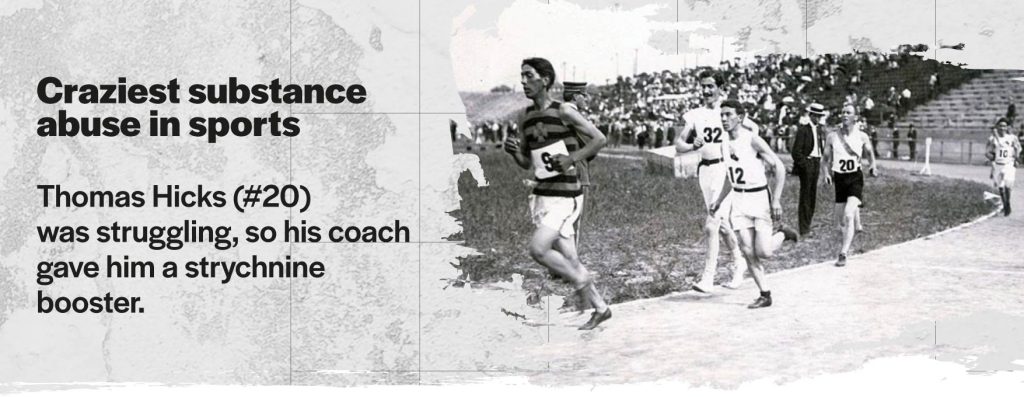Strap your seatbelts for a short history of substance abuse in sports. It’s hard to believe what’s been seen as performance-enhancing over the years.
Famously Dorando Pietri was disqualified after crossing the London 1908 marathon finish line first, because he was fainting and got a little push to complete his last few meters. Johnny Hayes, who was behind him, spotted this and reported the fact to the committee of referees… with whom he then had a fist fight, because he arrived at the finish line drunk. Wait, what? Drunk?
The amusing history of performance-enhancing drugs
Since the very beginning of professional sport there have always been those who instead of trying harder, took the path of being smarter… by cheating. It is in the nature of top athletes to try and win at all costs. However, in the past, cost wasn’t disqualification or law enforcement, but more like…. death.
Let’s have a look at some examples of substances considered performance-enhancing in the past which we wouldn’t touch today, never mind use for sport!
Tobacco and cigarettes
Tobacco was thought to have calming and relaxing properties for a long time. Old school tobacco intake was chewing (and spitting) tobacco leaves. Repackaged as cigarettes… wow, what a joy! Basically a must for every tired athlete in need of deep sleep. Tobacco does have a chemical compound which is mildly relaxing. It also has few annoying side effects such as disabling lungs, higher risk of throat and lung cancer, triggering heart conditions, tooth decay…. Research on cigarettes and these morbidities started in the 1940s, but it took a couple of decades for people to start changing their mindset about their beloved smokes.*
Cocaine and amphetamines
Heavy stuff. And yet, cocaine was the main ingredient of Coca-Cola, originally called the temperance drink (and for a good reason I bet) and other “energy drinks” of the late 19th century. Since cocaine wasn’t legally restricted at the time, it was used as a stimulant, especially for sprint and strength athletes. Those lucky enough to survive overdoses, extensive brain damage and complete change of personality, still had the problem of enhanced aggression and sudden mood swings. Amphetamines follow a similar history and use. Amphetamines and derivatives are still in use today as a treatment for attention disorders, but only strictly accessible under medical prescription.**
Strychnine
Better known as rat poison, and as little as 36mg can be lethal. Ignorance is bliss sometimes, and the pioneers of long distance running settled for ignorance. In the 1904 Olympic marathon Thomas Hicks, one of the participants, started to crawl and gasp, gripped by the incoming paralysis caused by strychnine (mixed with brandy, of course). His coach, spotting him having a hard time, promptly administered him a little strychnine booster, you know. The “positive effects” did not last long, and poor Hicks cut the finish line walking like a tin man, collapsing right after the end. In his defence, strychnine is a powerful neuromuscular stimulator, with merely one side effect: death. Oh, and he finished 6th. Worth it? Probably not.**
“cocaine was used as a stimulant for sprint and strength athletes”
Alcohol
It is common knowledge that alcohol inhibits and eventually destroys brain cells, as well as gradually degrading the functions of our liver. People from the past were tricked by that feeling of euphoric happiness that alcohol gives you, making you feel invincible, brave and strong.*** Unfortunately, inner feelings do not match reality: ethanol (the scientific name of alcohol) reduces reaction times, coordination, attention span and in the long term, the ability of your body to recover.****
Caffeine
Believe it or not, caffeine was once considered extremely dangerous. In the US, while people (and their kids) were casually sipping cocaine mixed in their drink, the government health department was very active in a scaremongering campaign about the dangers of caffeine. Paradoxically, 40 kegs of Coca-Cola were seized because they contained too much caffeine… with no mention of the cocaine.
Caffeine is a very powerful neurostimulator (a psychoactive drug in fact). And bear in mind, it does have many side effects: addiction, dehydration, abnormal heart rhythm, headaches (for some). However, it was liberalised a long time ago due to its very mild nature. You would need an extremely high dosage of caffeine (above 600mg at once) to risk serious, acute consequences.
Sugar
Sugar is controversial, and what do we even mean by it? Basically any carbohydrate with a very simple structure, but what we really focus on is the sucrose (aka table sugar). It can’t really be classified as a chemical substance because it technically is food. Its omnipresence has changed the world. In the year 1893 Doctor Osler wrote a compendium of the major widespread diseases at the time. Corpulence (what we would call obesity today) only affected 1 in 100 people in the US. Similar data applied to high blood pressure and diabetes (which had just been discovered). Fast forward one hundred years and boom! 2 billion people are overweight globally (39%!) and 13% are obese.******
Simply put research and historians agree in saying that in those countries where there is more sugar consumption the obesity levels skyrocket, with consequent risk of diabetes, metabolic syndrome and cardiovascular diseases.******
Having said so, sugar is no poison. Small amounts are more than fair if you are active enough, and sometimes almost necessary to recover during or after a prolonged effort. Examples: you have your weekly tennis training, try some drills, play a couple of sets. No need for sugar. Just wait for your next (healthy) meal. On the other hand, you are in a tournament, giving 100% and more, and the match is getting longer and longer. Sugary food can help replenish energy in your muscles (perhaps a banana or grapes).
Long story short, sugar should be consumed in very little amounts, and only when necessary!
Also contentious is cannabis.
Despite the crazy risks athletes ran experimenting with the drugs I’ve listed, an Olympic medical committee wasn’t formed until the Danish cyclist Knud Enemark lost his life during the Rome Olympic games in 1960 – after an amphetamine overdose.
Science is our best ally
Scientists of the time were convinced that the poisonous concoctions above were great and safe. So, you might say: “maybe today’s scientists are wrong too!”. Seen one way, this is true. But what makes science great is that it always questions itself. Everything can be improved. Each step forward makes us a little more informed and a little “less wrong” about sport.
References
*Sir Doll, R. (1999) ‘Tobacco: a medical history.’ Journal of urban health: bulletin of the New York academy of medicine, 76(3), 289- 313.
**Cooper, C. (2012) Run, swim, throw, cheat: the science behind drugs in sport. 1st Edition. Oxford: University Press.
***Atlas Obscura (2018) Remembering when runners drank champagne as an energy drink. [online] available from https://www.atlasobscura.com/articles/drinking-alcohol-when-running#:~:text=In%201908%2C%20the%20winner%20of,to%20cross%20the%20finish%20line.
****O’Brien, C. P., Lyons, F. (2000) ‘alcohol and the athlete.’ Journal of sports medicine, 29(5), 295-300.
***** Meeusen, R., Roelands, B., Spriet, L. L. (2013) ‘Caffeine, exercise and the Brain’ Nestlè nutrition workshop ser 76, 1-12
******Johnson, J. R., Sanchez-Lozada, L. G., Andrews, P., Lanaspa, M. A. (2017) ‘Perspective: a historical and scientific perspective of sugar and its relationship with obesity and diabetes.’ American society for nutrition, 8, 412-422.
Further reading
Kelly, J. (2015) ‘The consumption and sociable use of alcohol in eighteenth-century Ireland.’ Proceedings of the Royal Irish Academy, 115C, 219-255.





